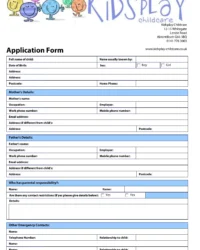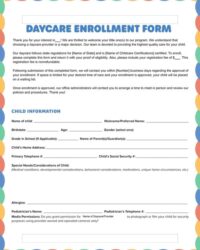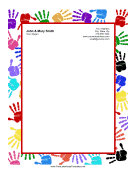Utilizing a pre-designed structure offers several advantages. Streamlined data collection simplifies administrative tasks, saving time and resources for childcare providers. Parents also benefit from a clear and concise format, ensuring they provide all necessary information, reducing potential delays in the enrollment process. Furthermore, consistent documentation practices support legal compliance and facilitate effective communication between the daycare center and families.
This foundational understanding of the purpose and advantages of organized application processes in childcare settings provides a basis for further exploration of related topics. Areas of interest might include best practices for designing these forms, legal considerations, and strategies for effectively managing the application and enrollment workflow within a daycare environment.
Key Components of a Childcare Enrollment Application
Effective enrollment applications gather comprehensive information to ensure the smooth integration of children into a childcare setting. These key components facilitate this process:
1. Child Information: This section collects fundamental details about the child, including full name, date of birth, gender, address, and any existing medical conditions or allergies. Accurate and complete information is vital for personalized care and emergency preparedness.
2. Parent/Guardian Information: Contact details for parents or legal guardians are essential for communication and emergency purposes. This typically includes names, addresses, phone numbers, email addresses, and employment information.
3. Emergency Contact Information: Listing individuals authorized to pick up the child and alternative emergency contacts ensures the child’s safety and well-being in unforeseen circumstances. Contact details and relationships to the child should be clearly specified.
4. Medical Information and Authorization: Details regarding the child’s health history, immunization records, allergies, and any existing medical conditions are crucial for providing appropriate care. Authorization for emergency medical treatment is also typically included.
5. Developmental History: Information about the child’s developmental milestones, current skills, and any special needs helps caregivers understand the child’s individual requirements and tailor their approach accordingly.
6. Prior Education/Childcare Experience: Understanding the child’s previous experiences in educational or childcare settings provides valuable context for their current development and helps ensure a smooth transition.
7. Signatures and Agreements: Parent or guardian signatures acknowledge the accuracy of the provided information and agreement to the daycare’s policies and procedures. This formalizes the enrollment agreement.
Comprehensive data collection ensures appropriate care and facilitates effective communication between the childcare provider and families, promoting a positive and safe environment for all children.
How to Create a Daycare Enrollment Application Template
Developing a comprehensive enrollment application template is crucial for childcare centers. A well-structured template ensures efficient data collection, facilitates smooth onboarding processes, and supports effective communication with families. The following steps outline the process of creating such a template:
1. Define Essential Information Categories: Begin by outlining the key categories of information required from prospective families. These typically include child information, parent/guardian details, emergency contacts, medical history, and authorization for treatment. Consider any specific requirements relevant to the daycare center’s programs or philosophy.
2. Structure Information Fields Logically: Organize information within each category in a clear and logical manner. Use subheadings and concise labels for each field to ensure clarity and ease of completion. Consider the flow of information and group related fields together.
3. Select Appropriate Input Formats: Choose appropriate input formats for each field, such as text fields, checkboxes, or dropdown menus, to facilitate efficient and accurate data entry. This also improves the readability and organization of the completed applications.
4. Incorporate Clear Instructions and Disclaimers: Provide clear and concise instructions for completing each section of the application. Include any necessary disclaimers or legal statements regarding data privacy and usage. This ensures transparency and informed consent.
5. Ensure Accessibility and Clarity: Design the template with accessibility in mind, using clear fonts, adequate spacing, and a visually appealing layout. A well-designed template enhances user experience and reduces potential errors during completion.
6. Review and Refine: Before finalizing the template, conduct a thorough review to ensure accuracy, completeness, and clarity. Seek feedback from colleagues or other childcare professionals to identify potential improvements and ensure the template meets practical needs.
7. Implement and Maintain: Once finalized, implement the template as part of the enrollment process. Regularly review and update the template to reflect changing regulations, operational requirements, or best practices in childcare administration.
A well-designed application template simplifies administrative tasks, improves communication, and ensures the collection of necessary information for effective childcare provision. Consistent application procedures support compliance requirements and contribute to a professional and organized enrollment experience for families.
Standardized forms for enrolling children in daycare serve as vital tools for gathering essential information, streamlining administrative processes, and fostering clear communication between families and childcare providers. A well-designed template ensures consistency in data collection, facilitates efficient record-keeping, and supports compliance with regulatory requirements. Key components encompass details regarding the child, parents or guardians, emergency contacts, medical history, and necessary authorizations. Careful attention to structure, clarity, and accessibility enhances the user experience for families and simplifies administrative tasks for childcare professionals.
Effective management of enrollment procedures contributes significantly to the smooth operation of any childcare facility. Investing time and effort in developing a comprehensive and user-friendly application template strengthens professionalism, enhances communication, and fosters a positive experience for families during the crucial onboarding process. This ultimately benefits the children by ensuring a well-organized and supportive environment from the very beginning of their childcare journey.


